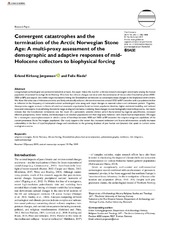Convergent catastrophes and the termination of the Arctic Norwegian Stone Age: A multi-proxy assessment of the demographic and adaptive responses of mid-Holocene collectors to biophysical forcing
Permanent link
https://hdl.handle.net/10037/18080Date
2019-07-31Type
Journal articleTidsskriftartikkel
Peer reviewed
Abstract
Using multiple archeological and paleoenvironmental proxies, this paper makes the case for a climate-induced convergent catastrophe among the human population of terminal Stone Age Arctic Norway. We show that climatic changes correlate with the termination of the so-called Gressbakken phase (4200–3500 cal BP), and unpack the middle-range mechanisms linking the Gressbakken termination to contemporaneous changes in the biophysical environment. We show that what was a Holocene extreme, and likely volcanically-induced, climate deterioration around 3550 cal BP coincided with a population decline as reflected in the frequency of radiocarbon-dated archeological sites along with major changes in material culture and settlement pattern. Together, these proxies suggest a return to forms of social and economic organization based on lower population densities, higher residential mobility, and reduced locational investments. In establishing the middle-range ecological mechanics mediating these changes into archeologically observable patterns, the results indicate that the Gressbakken termination was the result of a particularly unstable climate period characterized by regional paludification, increased effective precipitation, forest decline, and likely impacts on reindeer populations and their migratory behavior, with drastic human implications. We argue for a convergent catastrophe-scenario in which a series of hardships between 4000 and 3500 cal BP exceeded the adaptive mitigation capabilities of the contemporaneous Arctic Norwegian population. Our study supports the notion that increased sedentism and locational investment actually increases vulnerability in the face of rapid biophysical change and contributes to the growing database of past human ecodynamics that speak to current socio-ecological concerns.
Is part of
Jørgensen, E.K. (2020). Maritime Human Ecodynamics of Stone Age Arctic Norway: Developing middle-range causal linkages between climate forcing, demography, and technological responses. (Doctoral thesis). https://hdl.handle.net/10037/19458Publisher
Sage PublishingCitation
Jørgensen, E.K.J.; Riede, F.(2019) Convergent catastrophes and the termination of the Arctic Norwegian Stone Age: A multi-proxy assessment of the demographic and adaptive responses of mid-Holocene collectors to biophysical forcing. The Holocene. 29, (11), 1782-1800. https://journals.sagepub.com/doi/10.1177/0959683619862036Metadata
Show full item record
Copyright 2019 The Author(s)


 English
English norsk
norsk